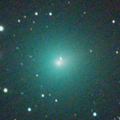
|
It approached to Earth down to 0.08 a.u. in mid December, and it brightened up to 3.4 mag (Dec. 14, Seiichi Yoshida). it looked so large as 3 times of Moon. Now it is fading. But it is very bright as 4.4 mag still now (Dec. 21, Marco Goiato). In the Northern Hemisphere, it stays observable in excellent condition. In the Southern Hemisphere, it is not observable until February.
Date(TT) R.A. (2000) Decl. Delta r Elong. m1 Best Time(A, h)
Dec. 29 6 28.00 54 38.0 0.109 1.078 148 3.8 23:52 (180, 71)
Jan. 5 7 44.65 59 4.1 0.143 1.100 142 4.5 0:47 (180, 66)
|
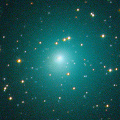
|
Now it is very bright as 9.0 mag (Dec. 14, Juan Jose Gonzalez). It is observable in excellent condition in the Northern Hemisphere. It stays low in the Southern Hemisphere.
Date(TT) R.A. (2000) Decl. Delta r Elong. m1 Best Time(A, h)
Dec. 29 2 50.18 30 18.1 0.706 1.540 130 9.4 20:20 ( 0, 85)
Jan. 5 3 7.13 29 23.5 0.771 1.577 127 9.7 20:10 ( 0, 84)
|
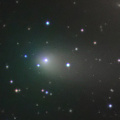
|
Now it is bright as 9.5 mag (Dec. 14, Marco Goiato). It stays 9-10 mag until January. In the Northern Hemisphere, it stays observable in good condition for a long time until it fades out. It locates low in the Southern Hemispehre.
Date(TT) R.A. (2000) Decl. Delta r Elong. m1 Best Time(A, h)
Dec. 29 8 34.55 39 43.5 0.779 1.699 149 9.7 2:07 (180, 85)
Jan. 5 8 35.48 42 6.4 0.800 1.732 152 10.0 1:40 (180, 83)
|
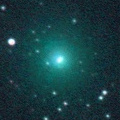
|
Now it is 10.1 mag (Dec. 4, Thomas Lehmann). It stays at 11 mag until February. In the Northern Hemisphere, it stays observable for a long time until it fades out. But it stays extremely low. It will never be observable again in the Southern Hemisphere.
Date(TT) R.A. (2000) Decl. Delta r Elong. m1 Best Time(A, h)
Dec. 29 18 46.06 17 44.4 2.362 1.746 41 10.9 18:27 (106, 8)
Jan. 5 19 7.35 20 9.0 2.356 1.767 42 11.0 18:32 (110, 7)
|

|
It brightened up to 7.7 mag in June (June 19, Juan Jose Gonzalez). Now it is fading. But it is still bright as 10.6 mag (Dec. 7, Chris Wyatt). In the Southern Hemisphere, it stays observable in good condition for a long time until the comet will fade out. In the Northern Hemisphere, it is not observable for a long time until autumn in 2019 when the comet fades out down to 16 mag.
Date(TT) R.A. (2000) Decl. Delta r Elong. m1 Best Time(A, h)
Dec. 29 19 35.53 -85 54.7 3.032 2.727 62 11.4 18:27 ( 5,-34)
Jan. 5 22 37.88 -85 54.1 3.041 2.772 64 11.6 18:32 ( 3,-32)
|
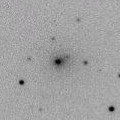
|
Bright new comet. Now it is 12.3 mag (Dec. 23, Ken-ichi Kadota). It will approach to Earth down to 0.3 a.u. in February. Then it will brighten up to 8.5 mag and will be observable in excellent condition.
Date(TT) R.A. (2000) Decl. Delta r Elong. m1 Best Time(A, h)
Dec. 29 14 16.22 -24 12.9 1.670 1.413 57 12.6 5:36 (327, 23)
Jan. 5 14 13.08 -23 38.0 1.449 1.372 65 12.2 5:38 (335, 27)
|

|
Now it is 11.5 mag (Dec. 14, Juan Jose Gonzalez). It stays 12 mag for a long time until spring.
Date(TT) R.A. (2000) Decl. Delta r Elong. m1 Best Time(A, h)
Dec. 29 7 27.87 -17 34.0 2.373 3.163 136 12.4 1:01 ( 0, 37)
Jan. 5 7 11.71 -19 12.0 2.402 3.201 138 12.5 0:17 ( 0, 36)
|

|
Now it is 13.3 mag (Dec. 5, Sandor Szabo). It stays at 12-13 mag for a long time until autumn in 2019.
Date(TT) R.A. (2000) Decl. Delta r Elong. m1 Best Time(A, h)
Dec. 29 22 47.53 -5 6.4 2.390 2.156 64 12.9 18:27 ( 44, 40)
Jan. 5 22 59.99 -4 8.7 2.442 2.137 60 12.8 18:32 ( 50, 38)
|
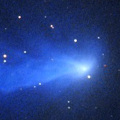
|
Now it is 13.1 mag (Dec. 4, Thomas Lehmann). It will be fading slowly after this. It is observable in good condition in the Northern Hemisphere. In the Southern Hemisphere, it is not observable until summer in 2019.
Date(TT) R.A. (2000) Decl. Delta r Elong. m1 Best Time(A, h)
Dec. 29 15 20.07 40 33.3 3.624 3.546 77 12.9 5:36 (247, 52)
Jan. 5 15 29.01 40 42.7 3.626 3.593 80 13.0 5:38 (247, 55)
|
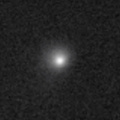
|
Now it is 14.0 mag (Nov. 26, Chris Wyatt). It will brighten up to 10-11 mag in autumn in 2019. It stays observable in good condition for a while in the Southern Hemisphere. In the Northern Hemisphere, it stays extremely low for a long time.
Date(TT) R.A. (2000) Decl. Delta r Elong. m1 Best Time(A, h)
Dec. 29 1 4.77 -34 55.4 4.322 4.322 83 13.5 18:34 ( 0, 20)
Jan. 5 1 3.09 -33 3.7 4.370 4.279 78 13.5 18:32 ( 6, 22)
|
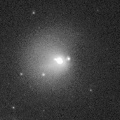
|
Now it is bright as 12.9 mag (Dec. 5, Sandor Szabo).
Date(TT) R.A. (2000) Decl. Delta r Elong. m1 Best Time(A, h)
Dec. 29 22 57.60 -0 6.0 6.050 5.768 68 13.6 18:27 ( 45, 45)
Jan. 5 23 1.16 0 13.5 6.153 5.768 62 13.7 18:32 ( 53, 41)
|
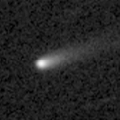
|
Now it is 13.7 mag (Dec. 10, Toshihiko Ikemura, Hirohisa Sato). It is observable at 14 mag in excellent condition until March.
Date(TT) R.A. (2000) Decl. Delta r Elong. m1 Best Time(A, h)
Dec. 29 11 15.74 0 16.7 1.044 1.632 107 13.9 4:47 ( 0, 55)
Jan. 5 11 25.32 -1 15.5 1.002 1.641 111 13.9 4:29 ( 0, 54)
|
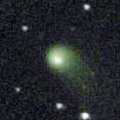
|
Now it is 14.0 mag (Nov. 14, Kunihiro Shima). It stays 13-14 mag until summer in 2019. It is not observable now.
Date(TT) R.A. (2000) Decl. Delta r Elong. m1 Best Time(A, h)
Dec. 29 17 7.97 -9 53.6 4.133 3.257 23 14.2 5:36 (286, 6)
Jan. 5 17 12.30 -11 6.1 4.085 3.254 28 14.2 5:38 (291, 10)
|

|
New bright comet discovered by three amateur comet hunters. It brightened rapidly from 10 mag up to 8 mag just after the discovery. But after that, the brightness evolution became slow, and it faded down to 9.5 mag in December (Dec. 9, Alan Hale). In the Northern Hemisphere, it will never be observable again after this. In the Southern Hemisphere, it will appear in the morning sky in February. But it may be fainter than 18 mag at that time.
Date(TT) R.A. (2000) Decl. Delta r Elong. m1 Best Time(A, h)
Dec. 29 19 32.86 -21 1.8 1.665 0.756 14 14.3 18:27 ( 68, -5)
Jan. 5 19 41.97 -23 13.1 1.848 0.893 9 15.4 18:32 ( 69,-11)
|
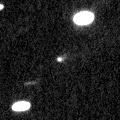
|
Now it is 14.8 mag (Dec. 10, Toshihiko Ikemura, Hirohisa Sato). It will brighten up to 13-14 mag in winter, and it will be observable in excellent condition. It locates low in the Southern Hemisphere.
Date(TT) R.A. (2000) Decl. Delta r Elong. m1 Best Time(A, h)
Dec. 29 11 22.41 27 43.4 1.540 2.148 114 14.4 4:54 ( 0, 83)
Jan. 5 11 29.20 28 5.2 1.473 2.141 119 14.3 4:33 ( 0, 83)
|
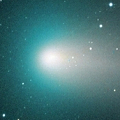
|
It brightened up to 6.8 mag in September (Sept. 17, Seiichi Yoshida). Now it is fading rapidly. It has already faded down to 13.8 mag (Dec. 15, R. Ramlow). It is observable in excellent condition in the Southern Hemisphere. It locates low after this in the Northern Hemisphere.
Date(TT) R.A. (2000) Decl. Delta r Elong. m1 Best Time(A, h)
Dec. 29 6 27.88 -37 52.8 1.060 1.760 118 14.4 0:00 ( 0, 17)
Jan. 5 6 19.68 -36 15.6 1.120 1.825 120 14.8 23:20 ( 0, 19)
|
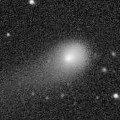
|
Now it is 14.4 mag (Dec. 12, Toshihiko Ikemura, Hirohisa Sato). It will be fading slowly after this. It is observable in excellent condition until spring in the Northern Hemispehre. In the Southern Hemisphere, it will be hardly observable after this.
Date(TT) R.A. (2000) Decl. Delta r Elong. m1 Best Time(A, h)
Dec. 29 11 38.80 39 12.1 4.133 4.623 114 14.4 5:10 (180, 86)
Jan. 5 11 30.94 40 9.1 4.071 4.658 121 14.4 4:35 (180, 85)
|

|
Now it is 14.3 mag (Nov. 30, Seiichi Yoshida). It stays at 14 mag until winter. It is observable in excellent condition in the Northern Hemisphere. In the Southern Hemisphere, it is not observable until summer in 2019.
Date(TT) R.A. (2000) Decl. Delta r Elong. m1 Best Time(A, h)
Dec. 29 13 22.60 78 34.4 1.488 2.048 110 14.4 5:36 (185, 46)
Jan. 5 13 30.39 79 13.2 1.504 2.070 110 14.5 5:38 (184, 46)
|

|
Now it is 14.5 mag (Aug. 16, P. Camilleri, H. Williams). It stays 15 mag from 2018 to 2019, and it will be observable for a long time in the Southern Hemisphere. In the Northern Hemisphere, it will never be observable again.
Date(TT) R.A. (2000) Decl. Delta r Elong. m1 Best Time(A, h)
Dec. 29 19 37.96 -65 48.7 4.582 3.933 43 15.0 18:27 ( 27,-27)
Jan. 5 20 1.18 -64 52.6 4.586 3.929 43 15.0 18:32 ( 29,-28)
|
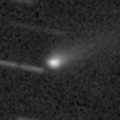
|
It brightened very rapidly up to 13.8 mag in August in 2017 (Aug. 22, Kunihiro Shima). Although it was faint as 16-17 mag in November, it brightened up to 14.7 mag in December (Dec. 12, Toshihiko Ikemura, Hirohisa Sato). In the Northern Hemisphere, it stays observable in excellent condition after this. It stays extremely low in the Southern Hemisphere.
Date(TT) R.A. (2000) Decl. Delta r Elong. m1 Best Time(A, h)
Dec. 29 11 23.03 33 50.7 2.145 2.725 116 15.1 4:55 ( 0, 89)
Jan. 5 11 25.48 35 0.8 2.106 2.754 121 15.2 4:29 ( 0, 90)
|
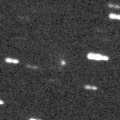
|
Now it is bright as 15.1 mag (Nov. 21, Artyom Novichonok). It stays 14 mag for a long time in 2019. In the Southern Hemisphere, it is observable in excellent condition. In the Northern Hemisphere, it is observable in low sky until early January, but it will be unobservable after that.
Date(TT) R.A. (2000) Decl. Delta r Elong. m1 Best Time(A, h)
Dec. 29 11 28.56 -39 58.1 3.399 3.476 86 15.2 5:00 ( 0, 15)
Jan. 5 11 25.58 -42 36.9 3.290 3.447 90 15.1 4:30 ( 0, 12)
|
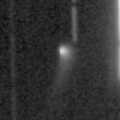
|
Now it is 15.2 mag (Dec. 10, Toshihiko Ikemura, Hirohisa Sato). It stays 15 mag until March. It is observable in excellent condition in the Northern Hemisphere. It is not observable at all in the Southern Hemisphere.
Date(TT) R.A. (2000) Decl. Delta r Elong. m1 Best Time(A, h)
Dec. 29 10 27.73 68 43.3 2.644 3.280 122 15.3 4:01 (180, 56)
Jan. 5 9 51.94 72 18.2 2.613 3.278 125 15.2 2:58 (180, 53)
|
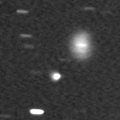
|
Now it is 15.0 mag (Dec. 5, Sandor Szabo). It is expected to brighten up to 7-8 mag in 2020. In 2018, it will be observable at 15-16 mag in good condition from autum to winter.
Date(TT) R.A. (2000) Decl. Delta r Elong. m1 Best Time(A, h)
Dec. 29 3 8.11 -4 27.3 5.083 5.685 123 15.6 20:37 ( 0, 51)
Jan. 5 3 5.04 -3 55.6 5.115 5.624 116 15.5 20:06 ( 0, 51)
|
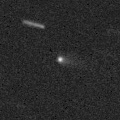
|
Although it was faint as 18 mag until Dec. 10, it suddenly brightened in outburst up to 15.4 mag on Dec. 12 (Dec. 12, A. Heinze). It stays observable in good condition for a while.
Date(TT) R.A. (2000) Decl. Delta r Elong. m1 Best Time(A, h)
Dec. 29 1 46.93 4 28.8 2.087 2.585 109 15.9 19:16 ( 0, 60)
Jan. 5 1 51.19 5 23.6 2.186 2.600 103 16.1 18:53 ( 0, 61)
|
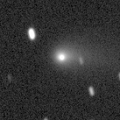
|
Now it is 14.6 mag (Dec. 5, Sandor Szabo). It will be fading after this. It stays observable in excellent condition for a while in the Southern Hemisphere. It locates somewhat low in the Northern Hemisphere.
Date(TT) R.A. (2000) Decl. Delta r Elong. m1 Best Time(A, h)
Dec. 29 23 57.36 -13 34.9 2.278 2.273 77 16.3 18:27 ( 19, 40)
Jan. 5 0 8.01 -11 59.3 2.379 2.298 73 16.5 18:32 ( 26, 39)
|
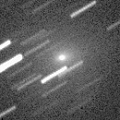
|
It approached to Earth down to 0.3 a.u., and brightened up to 8.3 mag in July (July 22, Juan Jose Gonzalez). Now it is fading. It has faded down to 13.2 mag in September (Sept. 24, Thomas Lehmann). Appearing in the morning sky in the Northern Hemisphere. It will appear in the morning sky in January also in the Southern Hemisphere.
Date(TT) R.A. (2000) Decl. Delta r Elong. m1 Best Time(A, h)
Dec. 29 15 28.78 -1 49.5 2.985 2.453 48 16.3 5:36 (297, 30)
Jan. 5 15 28.32 -0 54.2 2.941 2.527 56 16.4 5:38 (302, 36)
|
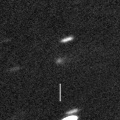
|
Now it is 17.4 mag (Dec. 10, Toshihiko Ikemura, Hirohisa Sato). It was predicted to be observable at 16.5 mag in good condition from autumn to winter. But recently, it is a bit fainter than predicted actually. It locates somewhat low in the Southern Hemisphere.
Date(TT) R.A. (2000) Decl. Delta r Elong. m1 Best Time(A, h)
Dec. 29 8 30.65 23 58.9 1.573 2.487 152 16.4 2:03 ( 0, 79)
Jan. 5 8 25.93 23 48.7 1.556 2.504 160 16.4 1:31 ( 0, 79)
|
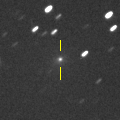
|
Now it is 16.7 mag (Nov. 29, Toshihiko Ikemura, Hirohisa Sato). It is observable at 16.5 mag in good condition in winter.
Date(TT) R.A. (2000) Decl. Delta r Elong. m1 Best Time(A, h)
Dec. 29 4 23.69 5 48.2 0.881 1.778 144 16.5 21:52 ( 0, 61)
Jan. 5 4 21.21 8 47.7 0.909 1.774 139 16.5 21:22 ( 0, 64)
|
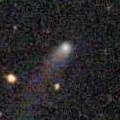
|
It brightened up to 14.7 mag in early 2018 (Jan. 25, Catalina Sky Survey). Now it is fading slowly. Now it is 16.4 mag (Dec. 10, Toshihiko Ikemura, Hirohisa Sato). In the Northern Hemisphere, it stays observable in good condition for a long time until the comet fades out. It is never observable again in the Southern Hemisphere.
Date(TT) R.A. (2000) Decl. Delta r Elong. m1 Best Time(A, h)
Dec. 29 6 37.33 72 32.4 5.404 6.091 130 16.6 0:12 (180, 53)
Jan. 5 6 13.88 72 58.1 5.446 6.116 129 16.7 23:14 (180, 52)
|

|
Now it is 16.1 mag (Dec. 12, Toshihiko Ikemura, Hirohisa Sato). It stays 16-17 mag for a long time until 2020. It is observable in good condition in the Northern Hemisphere. It is not observable at all in the Southern Hemisphere.
Date(TT) R.A. (2000) Decl. Delta r Elong. m1 Best Time(A, h)
Dec. 29 11 57.49 71 17.2 7.996 8.453 114 16.6 5:29 (180, 54)
Jan. 5 11 58.88 71 47.8 7.969 8.451 116 16.6 5:03 (180, 53)
|
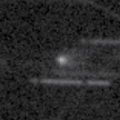
|
Now it is 17.3 mag (Dec. 10, Toshihiko Ikemura, Hirohisa Sato). It is observable at 17 mag in good condition in winter. It locates low in the Southern Hemisphere.
Date(TT) R.A. (2000) Decl. Delta r Elong. m1 Best Time(A, h)
Dec. 29 11 19.43 22 41.1 1.964 2.532 114 17.0 4:51 ( 0, 78)
Jan. 5 11 21.06 23 38.0 1.926 2.572 120 17.0 4:25 ( 0, 79)
|
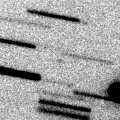
|
Now it is 17.9 mag (Dec. 10, Toshihiko Ikemura, Hirohisa Sato). It is observable at 17 mag in good condition in winter in the Northern Hemisphere. It locates very low in the Southern Hemisphere.
Date(TT) R.A. (2000) Decl. Delta r Elong. m1 Best Time(A, h)
Dec. 29 10 59.93 34 18.3 0.758 1.519 120 17.2 4:31 ( 0, 89)
Jan. 5 11 10.98 35 6.8 0.745 1.536 124 17.2 4:15 ( 0, 90)
|

|
Now it is 17.2 mag (Dec. 12, Toshihiko Ikemura, Hirohisa Sato). Fading slowly. It stays observable at 17 mag in good condition until summer in 2019.
Date(TT) R.A. (2000) Decl. Delta r Elong. m1 Best Time(A, h)
Dec. 29 11 42.95 5 56.2 9.642 9.913 103 17.2 5:14 ( 0, 61)
Jan. 5 11 43.49 6 5.4 9.540 9.923 110 17.2 4:47 ( 0, 61)
|

|
It brightened up to 7 mag from May to June in 2017. Now it is fading. It has already faded down to 15.9 mag (Dec. 8, Thomas Lehmann). In the Southern Hemisphere, it stays observable for a long time after this. It will never be observable again in the Northern Hemisphere.
Date(TT) R.A. (2000) Decl. Delta r Elong. m1 Best Time(A, h)
Dec. 29 0 51.13 -46 29.9 6.442 6.290 76 17.2 18:27 ( 1, 9)
Jan. 5 0 52.51 -45 27.2 6.573 6.349 72 17.3 18:32 ( 7, 9)
|
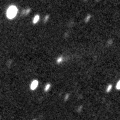
|
Now it is 16.0 mag (Dec. 10, Toshihiko Ikemura, Hirohisa Sato). It was observed at 18 mag in last winter. It will be observable in good condition at 16-17 mag also in this winter.
Date(TT) R.A. (2000) Decl. Delta r Elong. m1 Best Time(A, h)
Dec. 29 7 13.55 2 9.7 2.103 3.030 156 17.2 0:46 ( 0, 57)
Jan. 5 7 8.85 2 10.3 2.108 3.048 159 17.3 0:14 ( 0, 57)
|

|
It is expected to brighten up to 10 mag in autumn in 2019. Now it is 17.4 mag (Dec. 10, Toshihiko Ikemura, Hirohisa Sato). In the Northern Hemisphere, it stays observable for a long time while the comet is brightening. In the Southern Hemisphere, it it not observable until mid September in 2019.
Date(TT) R.A. (2000) Decl. Delta r Elong. m1 Best Time(A, h)
Dec. 29 13 36.27 53 1.6 3.203 3.496 99 17.5 5:36 (215, 66)
Jan. 5 13 44.88 55 45.0 3.073 3.427 102 17.3 5:38 (205, 66)
|

|
First return of a new periodic comet discovered in 2014. It has not been recovered yet. Now it is not detected, fainter than 20.0 mag (Dec. 10, Toshihiko Ikemura, Hirohisa Sato). The condition of this apparition is excelllent. It will brighten rapidly, and will be observable at 15.5 mag in excellent condition in March.
Date(TT) R.A. (2000) Decl. Delta r Elong. m1 Best Time(A, h)
Dec. 29 11 16.94 2 42.6 1.367 1.914 107 17.5 4:48 ( 0, 58)
Jan. 5 11 26.17 1 49.3 1.277 1.887 112 17.3 4:30 ( 0, 57)
|
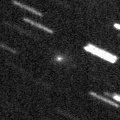
|
First return of a new periodic comet which brightened up to 17.5 mag in 2010. Now it is 17.0 mag (Nov. 29, Toshihiko Ikemura, Hirohisa Sato). It will be fading after this, and will be fainter than 18 mag in late January. It is observable in excellent condition in the Northern Hemisphere. It locates low in the Southern Hemisphere.
Date(TT) R.A. (2000) Decl. Delta r Elong. m1 Best Time(A, h)
Dec. 29 5 51.99 37 14.8 1.109 2.072 163 17.4 23:20 (180, 88)
Jan. 5 5 47.40 37 32.1 1.147 2.093 158 17.5 22:48 (180, 87)
|
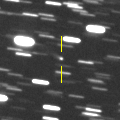
|
Now it is 17.2 mag (Nov. 29, Toshihiko Ikemura, Hirohisa Sato). It was observed at 17 mag in last winter. It will be observable in good condition at 17.5 mag also in this winter.
Date(TT) R.A. (2000) Decl. Delta r Elong. m1 Best Time(A, h)
Dec. 29 4 46.93 4 41.8 7.208 8.066 148 17.4 22:15 ( 0, 60)
Jan. 5 4 41.98 4 28.2 7.279 8.074 141 17.5 21:43 ( 0, 59)
|
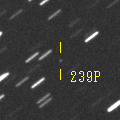
|
Now it is 17.8 mag (Dec. 14, Toshihiko Ikemura, Hirohisa Sato). It is observable at 17.5 mag in excellent condition in January.
Date(TT) R.A. (2000) Decl. Delta r Elong. m1 Best Time(A, h)
Dec. 29 8 15.01 5 25.8 0.732 1.655 149 17.5 1:47 ( 0, 60)
Jan. 5 8 14.55 3 24.2 0.710 1.650 153 17.4 1:19 ( 0, 58)
|
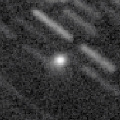
|
Now it is 18.7 mag (Dec. 14, Toshihiko Ikemura, Hirohisa Sato). It brightened up to 16 mag in 2018 spring. It stays observable in good condition until 2019 spring when the comet will be fainter than 18 mag. It is fainter than this ephemeris recently.
Date(TT) R.A. (2000) Decl. Delta r Elong. m1 Best Time(A, h)
Dec. 29 10 56.94 10 5.5 3.170 3.699 115 17.5 4:29 ( 0, 65)
Jan. 5 10 55.87 11 43.6 3.113 3.743 123 17.5 4:00 ( 0, 67)
|
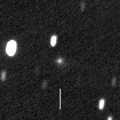
|
Now it is 17.2 mag (Nov. 29, Toshihiko Ikemura, Hirohisa Sato). It is observable at 17.5 mag until January, in good condition in the Northern Hemisphere. It locates very low in the Southern Hemisphere.
Date(TT) R.A. (2000) Decl. Delta r Elong. m1 Best Time(A, h)
Dec. 29 6 8.22 43 24.8 2.887 3.823 159 17.6 23:37 (180, 82)
Jan. 5 6 2.39 43 43.0 2.917 3.835 155 17.6 23:03 (180, 81)
|

|
It was expected to be observable at 17.5 mag in good condition in winter in the Northern Hemisphere. But actually, it is so faint as 21.0 mag (Oct. 5, K. Sarneczky, et. al). It locates low in the Southern Hemisphere.
Date(TT) R.A. (2000) Decl. Delta r Elong. m1 Best Time(A, h)
Dec. 29 5 24.58 34 27.1 2.088 3.038 161 17.7 22:53 ( 0, 89)
Jan. 5 5 19.18 34 41.1 2.112 3.030 154 17.7 22:20 ( 0, 90)
|
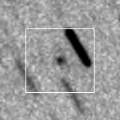
|
Now it is 17.7 mag (Dec. 8, Toshihiko Ikemura, Hirohisa Sato). First return of a new periodic comet which brightened up to 16 mag in 2011. It is observable at 17.5 mag in good condition in winter.
Date(TT) R.A. (2000) Decl. Delta r Elong. m1 Best Time(A, h)
Dec. 29 2 36.97 12 16.9 1.731 2.420 123 17.7 20:06 ( 0, 67)
Jan. 5 2 39.49 11 54.0 1.794 2.406 117 17.7 19:41 ( 0, 67)
|
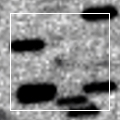
|
Now it is 18.8 mag (Nov. 29, Toshihiko Ikemura, Hirohisa Sato). It is observable at 18 mag in winter.
Date(TT) R.A. (2000) Decl. Delta r Elong. m1 Best Time(A, h)
Dec. 29 6 53.54 21 25.2 2.530 3.510 174 17.9 0:26 ( 0, 76)
Jan. 5 6 48.42 21 38.7 2.521 3.504 176 17.9 23:49 ( 0, 77)
|
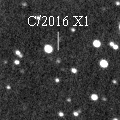
|
Now it is 18.1 mag (Dec. 14, Toshihiko Ikemura, Hirohisa Sato). It is observable at 18 mag in winter.
Date(TT) R.A. (2000) Decl. Delta r Elong. m1 Best Time(A, h)
Dec. 29 7 23.49 4 21.6 6.686 7.602 157 17.9 0:56 ( 0, 59)
Jan. 5 7 21.21 4 11.3 6.662 7.597 160 17.9 0:26 ( 0, 59)
|
|
![]()
 C/2017 B3 ( LINEAR )
C/2017 B3 ( LINEAR ) 240P/NEAT
240P/NEAT C/2018 A6 ( Gibbs )
C/2018 A6 ( Gibbs ) C/2018 A3 ( ATLAS )
C/2018 A3 ( ATLAS ) C/2017 T2 ( PanSTARRS )
C/2017 T2 ( PanSTARRS ) 243P/NEAT
243P/NEAT 48P/Johnson
48P/Johnson C/2018 N1 ( NEOWISE )
C/2018 N1 ( NEOWISE ) 59P/Kearns-Kwee
59P/Kearns-Kwee 171P/Spahr
171P/Spahr C/2016 A1 ( PanSTARRS )
C/2016 A1 ( PanSTARRS ) C/2010 U3 ( Boattini )
C/2010 U3 ( Boattini ) 164P/Christensen
164P/Christensen 247P/LINEAR
247P/LINEAR C/2014 B1 ( Schwartz )
C/2014 B1 ( Schwartz ) C/2015 V2 ( Johnson )
C/2015 V2 ( Johnson ) 361P/2017 S4 ( Spacewatch )
361P/2017 S4 ( Spacewatch ) C/2018 W2 ( Africano )
C/2018 W2 ( Africano ) P/2014 C1 ( TOTAS )
P/2014 C1 ( TOTAS ) 369P/2018 P1 ( Hill )
369P/2018 P1 ( Hill ) C/2015 XY1 ( Lemmon )
C/2015 XY1 ( Lemmon ) 239P/LINEAR
239P/LINEAR C/2018 E1 ( ATLAS )
C/2018 E1 ( ATLAS ) 159P/LONEOS
159P/LONEOS 232P/Hill
232P/Hill 373P/2018 R2 ( Rinner )
373P/2018 R2 ( Rinner ) 31P/Schwassmann-Wachmann 2
31P/Schwassmann-Wachmann 2 C/2016 X1 ( Lemmon )
C/2016 X1 ( Lemmon )![]()









































